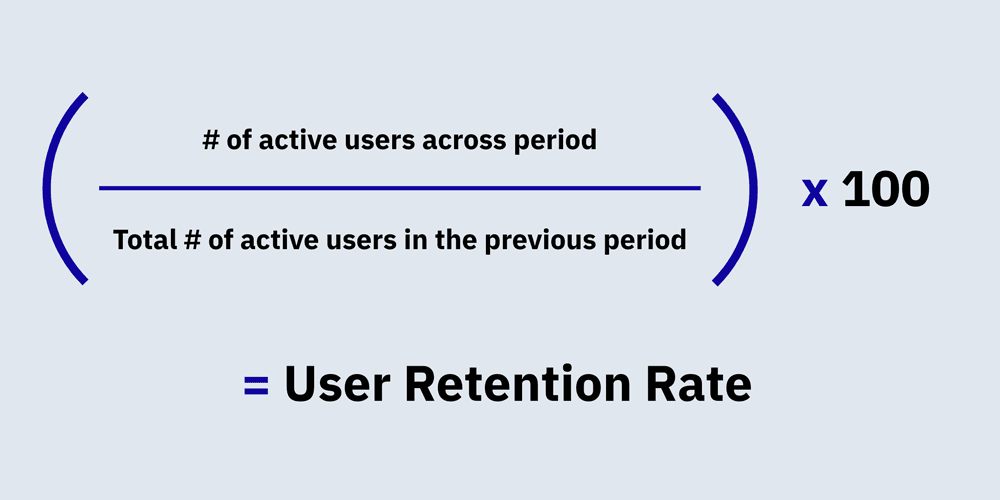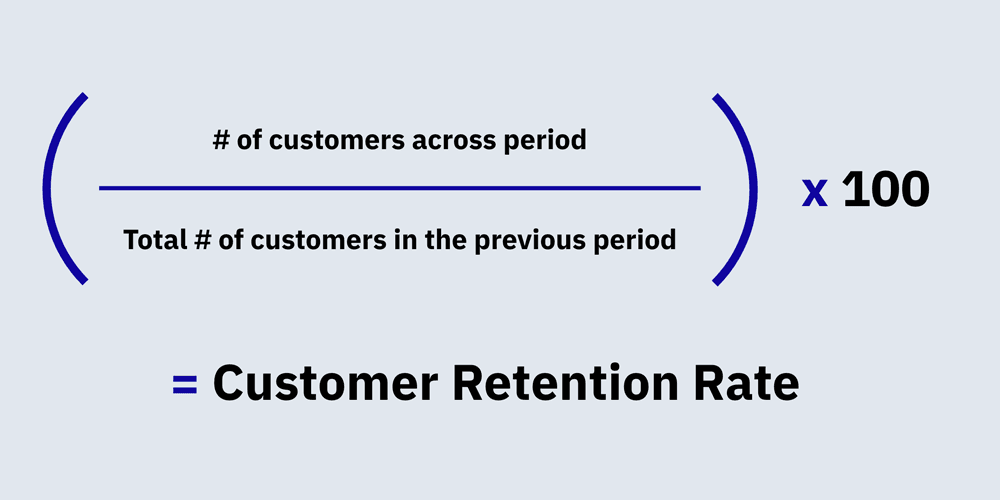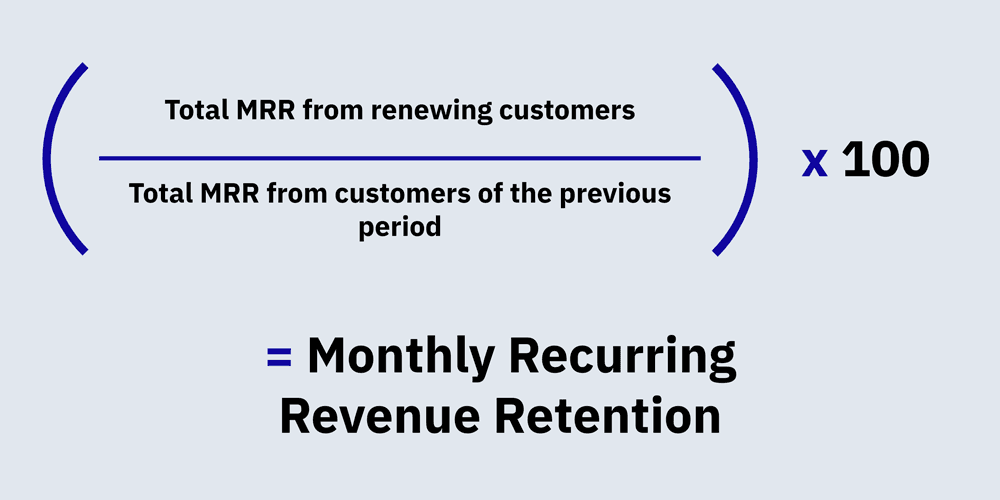How to Calculate Retention Rate in B2B SaaS
Understand different kinds of retention rate to keep your customers happy and your company healthy.
For SaaS professionals, retention rate can be what your company lives or dies by.
Knowing how to measure user retention has always been at the core of SaaS’s commercial philosophy. Looking at customer retention specifically, there are many different retention rates (user/customer/MRR), and keeping each of them high helps you keep your churn rate low and your business growing.
What Is Retention Rate?
Retention rate is the percentage of customers active in a given period who are still customers in the next period. It’s often calculated by a daily, weekly, or monthly time band. Those users who are still on your books, still using your product, still supplying you with MRR, have been retained. Those who aren’t have churned.
The various kinds of retention rates act as a good measure of how well your product is working for users. Retention can also be calculated with respect to employees, but our focus in this article is on the retention of users, customers, and revenue.
How to Calculate User Retention Rate
You can calculate user retention rate by dividing the number of active users your service has across a given period (let’s say active users in October) by the number of users in the previous period (the previous period was September). Here is the full formula for calculating user retention rate:
(Number of active users across period/Total number of active users in the previous period) x 100 = User Retention Rate [expressed as percentage]

User retention is the number of people who are actively using your product and gaining value from it — including customers, free users, and trial users.
There is no “correct” retention rate benchmark to aim for that holds across all SaaS industries. Rather, the key is to make sure your retention comfortably outpaces churn and allows for steady cash flow. Do not, however, be fooled by “good enough” retention rates. Whatever number is left over from your retention rate is churn, and churn rates that are even above a few percent can be harmful for your company growth over time.
Say, for example, you have a steady rate of 80% retention. On the surface, that looks like a good number for a B2B company — four users retained for every one churned. But 80% retention still means that after five years, you’ll have only 4,096 of the 10,000 users you started with. Of course, you’ll have brought in new business in that period, but you’ll need an awful lot of new business to make up that deficit.
Of course, if you’re in B2C, or other industry sectors like gaming, you’ll have a different benchmark for really good weekly retention rates. In those industries, a good week may see a retention rate of around 20%. The important thing is to determine the retention rate target that is right for your company.
How to Calculate Customer Retention Rate
Customer retention concerns the number of paying customers with active subscriptions against the total number of the previous period. The full formula for calculating customer retention rate is as follows:
(Number of customers across period/Total number of customers of the previous period) x 100 = Customer Retention Rate [expressed as percentage]

As we alluded to above, user retention and customer retention are not the same thing. Theoretically, customers can still be retained even after user churn if they are still paying for a subscription, for example.
How to Calculate MRR Retention Rate
Monthly recurring revenue (MRR) is the lifeblood of SaaS. It represents the most important form of retention for your business’s financial health. You can calculate it with the following formula:
(Total MRR from renewing customers) / (Total MRR from customers of the previous period) x 100 = Monthly Recurring Revenue Retention [expressed as percentage]

While MRR retention rate might be the one that gives you the best idea of your company’s short- to medium-term health, you shouldn’t give it total priority over user or customer churn rates. The various types of retention rate actually perform an important job when used together.
For instance, it’s important to assess both MRR and user retention in relation to one another. You may have a low user/customer churn and see this as reason enough to be happy with things as they are. However, the small number of customers/users you’ve churned may be from the most valuable segment(s) of all, providing the most MRR. Even a small loss from this pool of customers would therefore represent a sharp loss in revenue.
Likewise, if you’re simply relying on customer churn to measure satisfaction with your product, you’ll be missing out on users who’ve churned but who’ve not yet canceled their subscription. By comparing user and customer retention rates to this end, you can pinpoint at-risk customers more easily and return them to the fold.
How to Improve Retention
You’ll improve your retention rates somewhat by simply honing a company culture that emphasizes careful, conscientious work. But if you really need to juice your retention rates, consider some of the following strategies.
Invest in Your Customer Success and Onboarding Programs
Customer success is becoming increasingly important in SaaS, as more and more companies recognize the natural churn risk during onboarding. Guiding your new customer from signing on the dotted line to getting value from your product is vital for early retention. You might want to make a customer success–specific hire to this end or simply invest in good technology for easing that transition from sales prospect to paying customer.
Customer success involves more than just a couple of training sessions and regular emails asking for feedback (though both are useful). The best customer success plans are programmatic from the start, and taking care of the following areas is vital for success.
- Consult with your customer. You can’t deliver customer success without knowing what success looks like for your customer. Meet, ask questions, and set expectations.
- Practice good data hygiene. Customer success goals should be quantifiable—traffic increases by x%, conversion rates are up by y%. To make tracking these goals workable, make sure you’re practicing good data hygiene and documentation.
- Show your customer how to get value from your product. You know the old joke about the new customer who invested in the new solution, opened it once, and never opened it again? It’s no joke. Train your customers, giving them not only a general feeling for your product but also specific knowledge for what features will be most useful to them. Teaching your customers “how to fish,” by having a long-term relationship between user and support, is an important part of retention. Don’t just answer their questions point blank—tell them how their query relates to other parts of the product which they haven’t used yet. Use support to refresh your users’ impression of how broad and versatile your product’s feature array really is.
- Use product intelligence to analyze and improve customer experience and onboarding. Product intelligence combines product analytics, data management, and behavioral targeting to help you build great products and experiences for your users.
Customer success can be thought of as proactive customer support before the fact—before they reach out with a problem. Clients who’ve enjoyed a high degree of customer success will be happier and more likely to renew and will make great examples of your product’s usefulness for use in the sales process.
On top of that, an engaged customer success and/or support team will be picking up a great deal of information from your existing customers to then relay back to your Product team. That way, user feedback can more positively influence the product roadmap. Ignore that feedback at your peril. As Dropbox Product VP Adam Nash observed, “Nothing irritates customers more than to see you roll out new features that exclude the ones that they have already identified and requested actively.”
Provide Closer Levels of Customer Support
Providing strong and consistent levels of customer support is every bit as important as customer success and is also a great way to improve retention. Customers need to know that the support requests they submit will be tackled quickly and accurately.
Customer support is not just about preventing churn. It’s also a powerful way to let your customers know about the values and principles behind your business. You should take steps to ensure that your support specialists try to improve your customers’ experience in your product beyond the immediate scope of their issue. You never know when they might stumble upon a key functionality insight or even an entirely unexpected opportunity for upselling a customer, all from a humble support ticket.
Positive ripple effects from consistently good customer support can go even further. When referral traffic is becoming a key driver of pipeline health, there is nothing more likely to make a customer run to tell all of their friends about a product than a good experience with excellent customer service.
The End of the Road
To some degree, churn is inevitable in SaaS. No customer stays with a company forever. In fact, the best-case scenario is that after a long, fruitful relationship for both sides, your customer heads off into the sunset, knowing they couldn’t have scaled the peaks of their industry without your product in hand. That’s why retention rates are so important — they allow you to get to that stage.
Interested in going a step farther to understand your product’s retention? Download this packet of six worksheets to understand, improve, and calculate retention rate.

Kate Adams
Former Product Manager, Amplitude
Kate is a former product manager at Amplitude focused on improving customer adoption. She's always looking for excuses to visit new places, learn new things, and eat unusual food.
More from Kate




